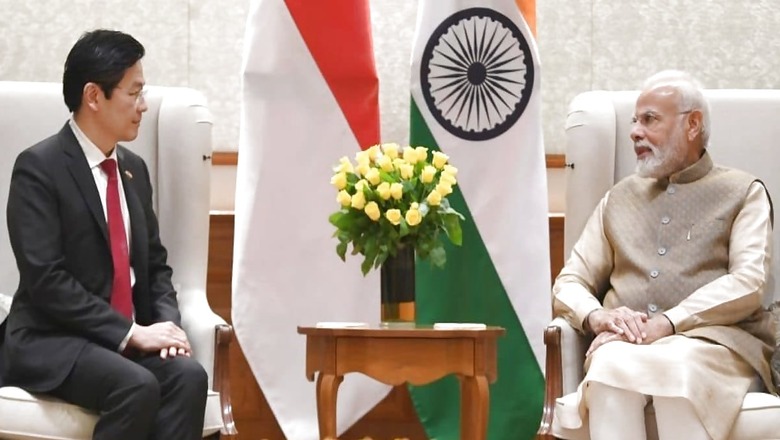
views
Singapore is a major highlight of the prime minister’s Southeast Asia tour. According to Singapore’s Foreign Minister, Vivian Balakrishnan, a recently concluded high-level meeting between top Indian cabinet ministers with their Singaporean counterparts has laid the groundwork for PM Modi’s visit. Earlier in August, India’s Finance Minister Nirmala Sitharaman, Foreign Minister S Jaishankar, Commerce and Industry Minister Piyush Goyal and Railway Minister Ashwini Vaishnav were all in Singapore for a roundtable meeting with their counterparts. This sheds light on the sheer extent of deals planned out ahead of PM Modi’s visit.
Singapore can participate in India’s growth story using its financial heft and advanced technologies. India is spending record amounts on infrastructure developments and this is where Singapore can be involved to build Indian cities. The two nations are also expected to sign a pact on semiconductor manufacturing which can boost India’s plans to build a domestic chip-manufacturing base.
Singapore is a global financial powerhouse known for its towering skyscrapers and efficient governance. It is a city-state located at the southern tip of the Malay Peninsula, a strategic maritime hub that links major trade routes between Asia, Europe, and beyond. With a population of just over 5 million and an area only half the size of Delhi, Singapore may be small, but its influence is anything but. One of the four Asian Tigers, Singapore has grown phenomenally since its independence in 1965 and is an economic marvel for all to see. Its nominal GDP is almost half a trillion dollars. It was $466 billion in 2022. Its per capita income is somewhere over $84,000 which is higher than any other ASEAN nation.
Singapore is much more than just a financial hub. It is also a prominent trade and logistics hub. Located on the Strait of Malacca, Singapore is at the crossroads of major global shipping routes connecting the Indian Ocean with the South China Sea and the larger Pacific Ocean. As China’s belligerence in the South China Sea grows, India is strengthening ties with key Southeast Asian nations like Singapore. And the two nations are historically and culturally linked.
Singapore is one of the Indianised lands that had been part of what is called the Indosphere, for centuries. In fact, Singapore’s name which translates into ‘Lion City’ is actually derived from the ancient Indian language Sanskrit. Tamil is one of the four official languages. And there is a very large Indian diaspora living in Singapore and involved in nation-building.
Defence collaboration is a cornerstone of this relationship. India and Singapore regularly conduct joint naval exercises like SIMBEX, which have become increasingly sophisticated over the years. Singapore allows the Indian Air Force to use its bases for training. The Indian Navy has access to its Changi naval base which helps India maintain its naval presence in the strategically crucial region. The two nations signed an agreement in 2017 which allows ships from both navies to refuel, restock, and rearm at each other’s military bases.
On the trade front, Singapore is India’s second-largest trading partner in ASEAN, with bilateral trade exceeding $30 billion. Key sectors include advanced manufacturing and financial services. Meanwhile, Singapore’s investors are investing heavily in India. The city-state is one of the largest sources of foreign direct investment in India. The recent link-up between Singapore’s PayNow and India’s UPI is a game-changer, facilitating instant cross-border transactions. Imagine transferring money across borders in real-time—this is the future of financial connectivity, and India is leading the charge alongside Singapore.
With India’s aviation sector poised to grow exponentially—with over 1,000 aircraft on order—Singapore’s expertise in aviation industries like maintenance, repair and overhaul (MRO) presents immense opportunities for collaboration. The two nations are also working closely on maritime connectivity, enhancing regional supply chains. Singapore’s Prime Minister, Lawrence Wong, has expressed optimism about Modi’s visit, highlighting new areas of cooperation that could lead to closer strategic ties between the two nations. The future potential for Foreign Direct Investment (FDI) from Singapore into India is immense, particularly in sectors like aviation and maritime connectivity.
After gaining independence in 1965, Singapore faced threats from China-backed communist movements as well as potential domination by Malaysia and Indonesia. To counter these risks, Singapore sought a close strategic partnership with India, viewing it as a counterbalance to Chinese influence and a key partner in ensuring regional security.
The country, whose political heft outweighs its size, supported India during the 1965 war with Pakistan and continues its support on the Kashmir conflict, working together against terror financing. Singapore’s strategic location makes it a key partner in countering China’s Belt and Road Initiative (BRI). Both countries are keen on ensuring that the Indo-Pacific remains open, free, and inclusive. This visit by PM Modi is expected to deepen these collaborations, setting the stage for a new era of India-Singapore relations.
Next, we move to Brunei, an oil-rich Islamic nation that might not always be in the headlines but plays a crucial role in India’s Act East Policy. Located on the northern coast of Borneo, Brunei offers India a strategic entry point into the South China Sea, a region that’s becoming increasingly contested. Though Brunei is small and rich, thanks to its vast reserves of oil and natural gas, which power its economy.
In recent years, India has been strengthening its defence ties with Brunei. Indian naval and coast guard ships frequently visit Brunei and Indian defence companies also participated in Brunei’s Defence Industry Expo for the first time this year. These ties are crucial as India looks to counter China’s growing influence in the region. Bilateral trade between India and Brunei is modest but growing, particularly in sectors like oil and gas. Indian companies are becoming increasingly involved in Brunei’s energy sector, and there’s potential for further collaboration, especially in renewable energy.
With a small yet significant Indian diaspora in Brunei, the people-to-people ties add another layer to this relationship. These Indian expatriates play key roles in Brunei’s oil and gas industry, further strengthening the bond between the two nations.
These visits are not just about bilateral ties—they’re about strengthening India’s position within ASEAN, a region that’s becoming increasingly crucial in global geopolitics. India’s ties with ASEAN have been on the upswing, particularly in the areas of trade and defence. India is ASEAN’s seventh-largest trading partner, with bilateral trade crossing $110 billion.
Defence ties are also deepening, with joint exercises and defence sales, particularly with countries like Vietnam and the Philippines. Of late, India has broken into the regional arms market in Southeast Asia. In April this year, India delivered the first batch of BrahMos missiles to the Philippines as part of a $375 million deal. This is India’s largest defence export deal to date. Under this agreement, India will supply the Philippine Marine Corps with three batteries of these cruise missiles.
China’s aggressive posturing in the South China Sea has made ASEAN wary, and countries in the region are increasingly looking to India as a counterbalance. India’s outreach through its Act East Policy, combined with its growing economic and military capabilities, makes it a natural partner for ASEAN nations looking to diversify their strategic options. PM Modi’s visits to Singapore and Brunei will set the stage for even closer ties with ASEAN. As India continues to rise, its relationship with ASEAN will be crucial in shaping the future of the Indo-Pacific region.
Views expressed in the above piece are personal and solely that of the author. They do not necessarily reflect News18’s views.




















Comments
0 comment